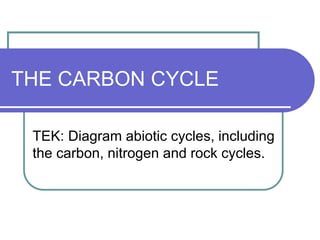
Carbon_Cycle.ppt
- 1. THE CARBON CYCLE TEK: Diagram abiotic cycles, including the carbon, nitrogen and rock cycles.
- 2. What Is Carbon? An element: 6 protons, 6 neutrons The basis of life of earth Found in all earth systems
- 3. Carbon Cycle The same carbon atoms are used repeatedly on earth. They cycle between the atmosphere, hydrosphere, geosphere and biosphere.
- 4. Processes that transfer carbon Between earth systems - Photosynthesis - Respiration - Consumption - Decomposition - Combustion (Burning) - Weathering (rocks break down and release carbon) - Dissolve/Vaporize (Between ocean and atmosphere)
- 5. Plants consume and release Carbon Dioxide Plants pull carbon from the atmosphere or hydrosphere and use it to make food – — photosynthesis. Plants release carbon by respiration.
- 6. Animals consume and release carbon When organisms eat (consume) plants or other organisms, they take in the carbon and some of it becomes part of their own bodies. When they breath (respiration) they release carbon.
- 7. Plants and Animal Die When plants and animals die, most of their bodies are decomposed and carbon atoms are returned to the atmosphere. Some are not decomposed fully and end up in geosphere deposits underground (soil, oil, coal, etc.) or at the bottom of ocean.
- 8. Natural combustion Forest and grass fires are a natural, required part of the carbon cycle that release carbon into the atmosphere and geosphere. Fire returns carbon to the soil and “cleans out” unhealthy plants, allowing new plants to grow.
- 9. Carbon Slowly Returns to Atmosphere Carbon in rocks and underground deposits is released very slowly into the atmosphere. This process takes many years and is usually caused by weathering.
- 10. Carbon in Oceans Oceans store large amounts of carbon. Largest exchange of carbon in carbon cycle is the dissolving and vaporization of carbon dioxide between the atmosphere and ocean surface.
- 11. Oceans store carbon on ocean floor. Many animals pull carbon from water to use in shells, etc. When these animals die, the carbon substances are deposited at the bottom of the ocean.
- 12. Carbon Cycle Diagram Carbon in Atmosphere Plants use carbon to make food Animals eat plants and take in carbon Plants and animals die Decomposers break down dead things, releasing carbon to atmosphere and soil Bodies not decomposed — after many years, become part of oil or coal deposits Fossil fuels are burned; carbon is returned to atmosphere (Unbalanced) Carbon slowly released from these substances returns to atmosphere
- 13. Balanced Carbon Cycle QuickTime™ and a decompressor are needed to see this picture.
- 14. Unbalanced Cycle - Human Impact Under balanced conditions, fossil fuels release carbon stores very slowly into atmosphere. When humans burn fossil fuels, it releases a tremendous amount of carbon into the atmosphere over a very short time span. Increased carbon dioxide in atmosphere increases global warming Fewer plants mean less CO2 removed from atmosphere
- 16. What is your carbon footprint? A carbon footprint is the amount of carbon emitted into the atmosphere by your personal, day-to-day activities. Examples: Type of car you drive, how far you drive your car, how much electricity you use (electricity primarily comes from burning coal), where the food you buy is grown and airplane flights. Why do we care?? GLOBAL WARMING
- 17. Things you can do to reduce your carbon footprint Promote plant life, especially trees Buy a fuel efficient vehicle Purchase locally grown food Reduce electricity use Reduce how far/much you drive Take less airplane trips Reduce, Reuse, Recycle!
- 18. CFA 1. Why is the carbon in the atmosphere increasing? 2. Of the seven processes that transfer carbon, what is the only one that reduces the carbon in the atmosphere? 3. Why are we worried about the amount of carbon in the atmosphere?